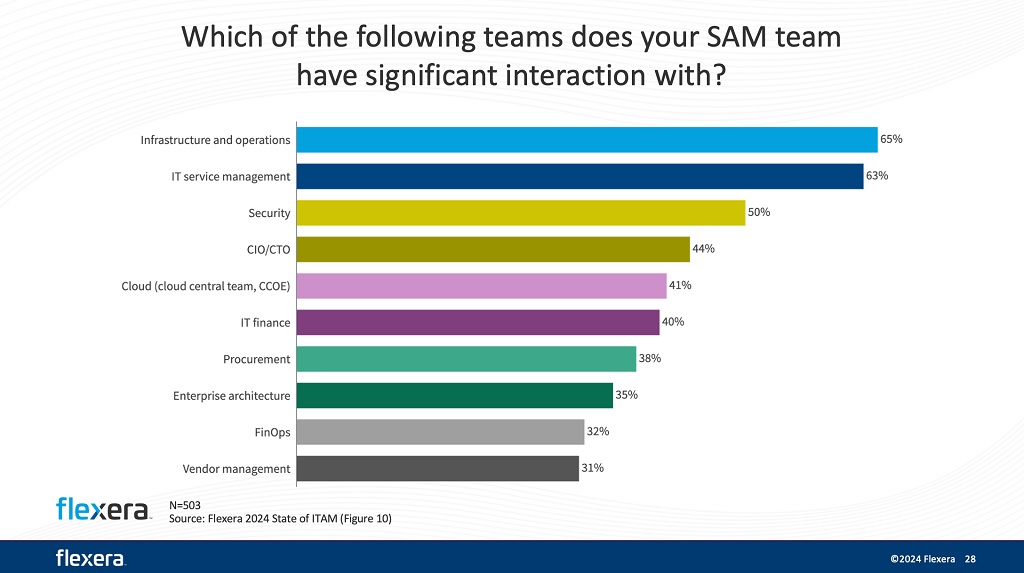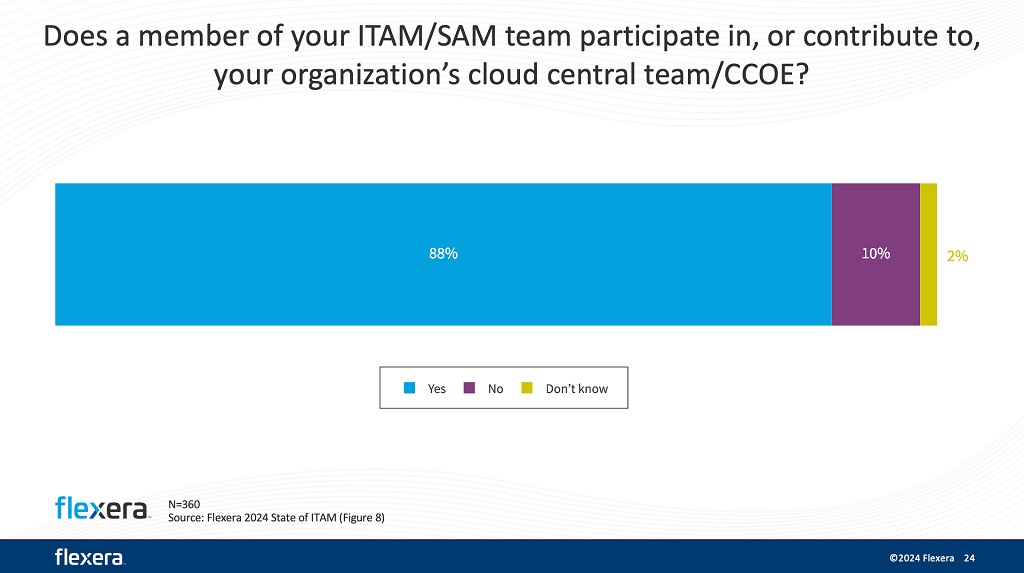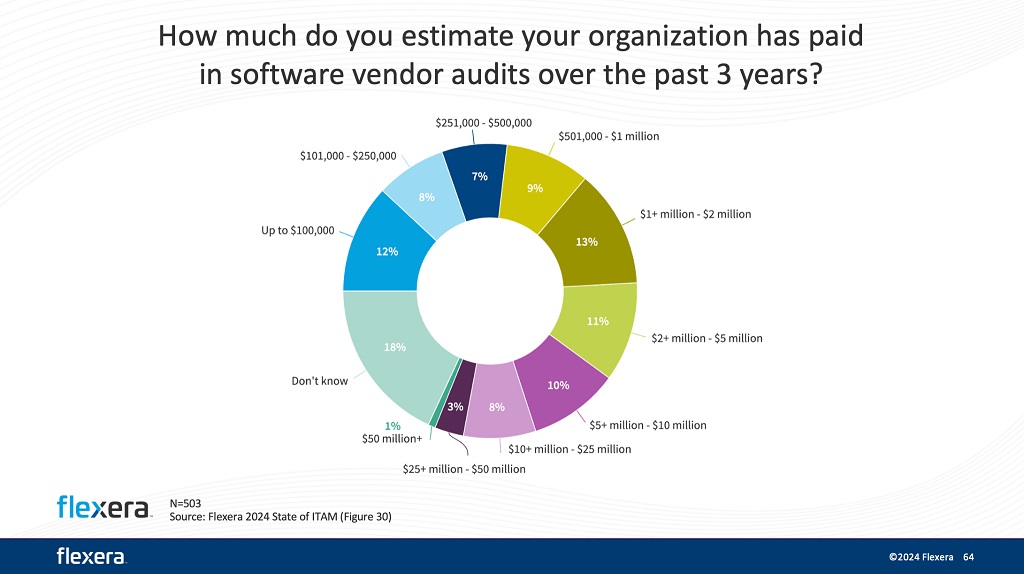The complex landscape of IT asset management (ITAM) presents evolving challenges — and noteworthy achievements. The Flexera 2024 State of ITAM Report offers a deep dive into how ITAM is evolving. Based on insights from over 500 IT professionals, the report underscores the need for improved collaboration and visibility to optimize IT investments.
At the forefront of this year's findings is the critical gap between software asset management (SAM) and FinOps (cloud financial management) teams. This year, 32% of SAM teams reported having significant interactions with FinOps teams. While this marks an improvement from last year's 25%, it highlights the persistent challenge of integrating these two essential functions that both emphasize cost optimization as part of an important and broad set of initiatives, including lifecycle management, tracking of inventory, software versioning, and more.
Without this integration, organizations risk inefficiencies and missed opportunities for cost savings. As the analogy goes, companies have all the puzzle pieces but have yet to start putting them together. When IT asset management teams are flexible, manage a comprehensive view of the enterprise's data, and share actionable data-driven insights with other teams in the enterprise, great efficiencies are possible.
1. COLLABORATION IS GROWING, BUT IS INSUFFICIENT
Saving the almighty dollar is more important than ever. Finding those dollars to save, wherever possible, is going to be looked on in a positive light. ITAM folks are trying to find where to do that; FinOps teams have historically been trying to do that. We're heading in the right direction, but more collaboration is necessary.
Today there's a lack of significant interaction between SAM and FinOps teams, making it a major concern. Despite the improvement from last year, collaboration is still far from where it needs to be. Organizations have gathered the right people, but have not yet figured out how to bring responsibilities and goals together effectively. This disjointed approach can lead to inefficiencies and missed opportunities for optimization across IT investments.

Improved cross-team collaboration between ITAM (including SAM) and FinOps will deliver efficiencies in the coming years. Working together is an essential part of illuminating — and eliminating — the significant visibility gap regarding licenses for software running in the cloud.
Collaborative efforts for SAM teams are important for various focus areas, including infrastructure and operations, security, cloud (including cloud central teams and cloud centers of excellence). For example, the report's findings also show that only 19% of respondents feel secure in their BYOL (bring your own license ) positioning. This low confidence indicates that BYOL efforts are a significant area where better integration and visibility could drive improvements.
2. CLOUD SERVICES AND LICENSING COMPLEXITIES ADD TO THE NEED FOR GREATER VISIBILITY
Cloud environments add another layer of complexity to ITAM, particularly concerning various licensing models and discount options. The resource costs and the licensing implications must both be considered when optimizing cloud environments.
Consider this example: a company is running Microsoft SQL Server workloads in Azure. If the workloads would be moved to reserved instances without considering the associated licenses, the company could have saved on instance costs, but would have incurred higher overall expenses due to new licensing requirements.
CCOEs provide a centralized approach to managing an organization's cloud journey. Enterprises are wise to include ITAM practitioners in their CCOEs in order to ensure that licensing is incorporated into cloud-cost planning and deployment. Today 72% of organizations have a central cloud team, such as a CCOE; 88% of CCOEs have an ITAM/SAM member on the team, helping guide an organization's cloud journey.
While cloud providers offer tools to help manage and optimize cloud costs, many organizations find these tools insufficient as they mature in their cloud journey. Initially, provider tools like AWS Trusted Advisor and Azure Cost Management can be beneficial, but as organizations grow, they often outgrow these tools and seek more comprehensive third-party solutions.

3. VENDOR AUDITS MAY CAUSE SIGNIFICANT FINANCIAL IMPACT
A positive trend is highlighted in this year's report: a decline in wasted IT spend. Historically, wasted spend has been a significant issue, but this year's report shows a decrease below the 30% threshold. This reduction is encouraging, indicating that organizations are becoming more efficient in managing their IT assets.
However, the financial impact of vendor audits remains significant. The report shows that more than 20% of respondents spent more than $5 million in software vendor audit costs over the past three years. This substantial expenditure underscores the need for robust ITAM practices to avoid such costly audits, particularly as major vendors (including IBM, Oracle, and ServiceNow) increase their audit activities. Perhaps unsurprisingly, responding to these audits is now the top initiative for ITAM teams that report to the CIO or CTO.
Being proactive — getting your internal house in order — allows you to worry less about external audits. Internal audits not only help ensure that you're in a good state; they reduce the time and money spent on external audits.

Broad Responsibilities, Broad Benefits
The report underscores the critical need for improved collaboration and visibility within ITAM practices. Today's ITAM professionals take on a broad range of responsibilities, including tracking ownership of SaaS usage, providing security analysis, getting ready for contract renewals, and maintaining software licensing inventories. As organizations continue to navigate the complexities of modern IT environments, integrating ITAM initiatives into FinOps and other initiatives, leveraging advanced tools, and enhancing data visibility will all be essential for optimizing IT investments and driving operational efficiency.
